In this article we look at the importance of branded searches and how to calculate the split between brand and non-brand search traffic.
Branded traffic is very rarely traffic you’d be happy to have leak through to another site. Aside from ‘reviews’, you’d hope that 100% of branded searches land on your site.
Unfortunately we see that this is not always the case.
Between the floorboards of SEO and PPC there are cracks that rob you of valuable visits, sometimes deliberately, often by simple chance.
In a recent talk at BrightonSEO Rand Fishkin of SparkToro (and previously Moz) suggested that the future of SEO is in the SERPs and less ‘on the site’. Whilst there is a growing trend in enhanced search results, data cards and featured snippets, there will always be a place at the table for digital (organic) brand reputation.
Branded vs non-branded traffic
If I were to offer you 100 new visitors that come via a branded search or 1,000 who come via a generic non-branded search term – which would you chose? I suppose the answer will depend on a range of factors, one of which is your conversion rate. Regardless, it’s likely that exposure to the brand will have increased their likelihood to either convert or to investigate… and then convert!
Understanding what percentage of your traffic is branded will help you to understand just how much effort you have to put in to brand protection and brand reputation management.
Measuring your brand/non-brand split
We’ll walk you through how to see your brand vs non-brand split without any need for paid tools or insane extrapolations of Google Analytics data.
1. Start by ensuring you are logged into a Google account with access to your Google Search Console (formerly Webmaster Tools).
2. Following this, visit https://datastudio.google.com in a separate tab and create a fresh blank report…
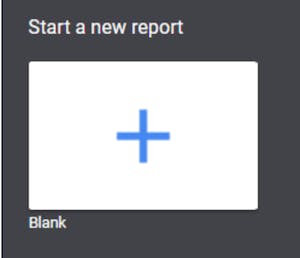
The phrase: “It’s so fine and yet so terrible to stand in front of a blank canvas” comes to mind!
3. Now, click in the bottom right of your screen to create a new data source.
![]()
4. Select the Google Search Console connector as shown below.
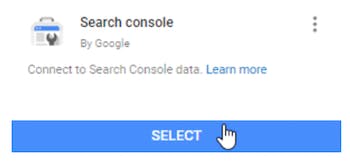
5. You may need to provide authorisation to Google Data Studio.
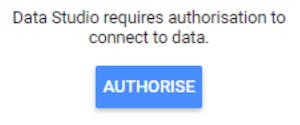
6. Now find your site in the list and select URL Impression and the ‘Connect’ button in the top right.

7. You should now be presented with a list of fields, however, we want to make a new one! Simply click the ‘add a field’ button.
8. The code you need can be seen below. The expression we have used will look for any search term containing either “zaz” or “zle” (from Zazzle Media) – you’ll need to replace these with your brand terms. Keep this simple and short.

You can add more between the speech marks with a |.*text here.* expression.
9. Give the field a name (such as ‘Branded Split’), save it and we’re almost there!
10. You may still need to add the data source to the blank template, select it from the list to the right and click “Add to Report”
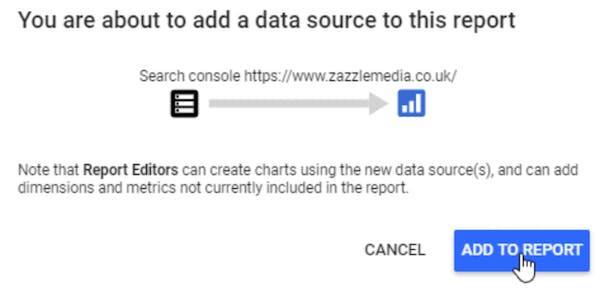
11. Your report will change into a grid and you can now make your chart show brand vs non-brand.
12. Select the type of graph you want to use (I favour area graphs personally) and draw an appropriately sized rectangle. When the graph is selected you’ll need to adjust the ‘Data’ menu to show:
- Time Dimension: Date
- Breakdown Dimension: Branded Split (or whatever you called your field)
- Metric: URL Clicks
13. You can adjust how the chart displays in the ‘Style’ menu. Below is my example where I have disabled stacking to show separate lines.

14. Changing your metric to ‘Impressions’ can allow you to quickly see the difference between the two, it often helps to highlight where you may rank for a huge keyword that is unrelated such as a celebrity or a similarly named brand.
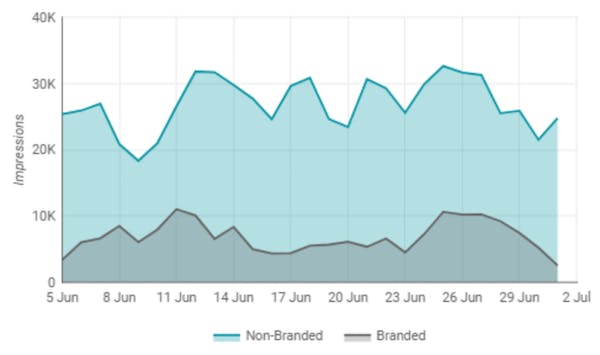
15. While this information is useful you may find it difficult to understand how the data averages out – as such, a pie chart may provide you with a clearer ratio.
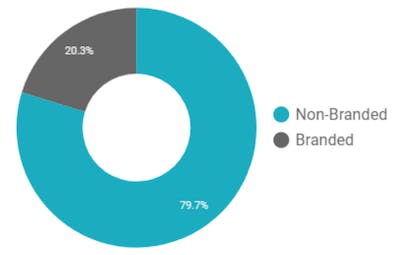
If you’ve enjoyed this dabble into Data Studio, let us know in the comments and we’ll be sure to produce more insightful posts using it.
Learn more
- Download Econsultancy’s SEO Best Practice Guide
- Take Econsultancy’s SEO training course

Great article!
Be careful if you cut and paste the expression as the “smart quotes” used in this article will cause an error.
Hi Jeff – thanks for your comment! We’ve gone in and added some <code> tags around the expression so that it can be copied and pasted directly.
I tried the formula (and replaced the smart quotes with correct ones) and got invalid formula.
Hi Howard, you may find it easier to type out the formula yourself as copying and pasting can sometimes alter the characters required, if it still isn’t working please provide access to stuart.shaw@zazzlemedia.co.uk and I will resolve this issue with you.
Also getting an error.
Hi Albert, you may find it easier to type out the formula yourself as copying and pasting can sometimes alter the characters required, if it still isn’t working please provide access to stuart.shaw@zazzlemedia.co.uk and I will resolve this issue with you.
I have tried the formula, it’s showing invalid
Hi Ayelita, you may find it easier to type out the formula yourself as copying and pasting can sometimes alter the characters required, if it still isn’t working please provide access to stuart.shaw@zazzlemedia.co.uk and I will resolve this issue with you.
Doesn’t work, shows as invalid, also that code snippet in the image is hard to see. However it also shows the THEN statement as being black and not recognized?
Thanks! Very useful. Works flawlessly.
The integration of GSC with GA also makes it easier to separate the data for multiple brand names under Regular Expression. The only problem is there is this data above 5000 queries which used to go under the category (other) for it being encrypted will still be a mystery.
Great article and easy to put into place. When I use the brand/non brand filter my impressions and clicks dont add up at all. E.g. I filter for brand queries, then for non brand queries I dont have the nearly the same number as when the filter isnt set. Do you know why that is? Thanks and BR